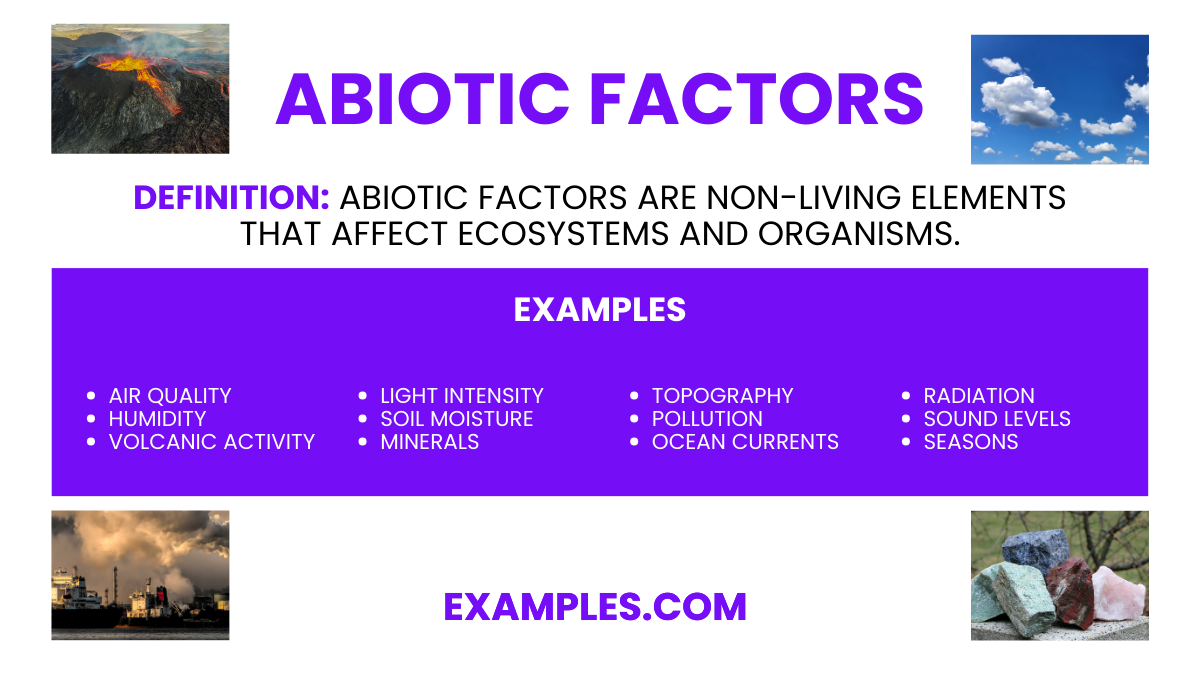Which of the following is an abiotic factor in an ecosystem?
Plants
Animals
Soil
Bacteria


An Abiotic factors is a non-living elements that play a crucial role in the environment, influencing the survival, growth, and development of organisms. This guide dives into the diverse range of abiotic factors, from sunlight and temperature to water and soil composition, providing clear examples to illuminate their impact on ecosystems. Ideal for teachers and students, this resource simplifies complex concepts, offering a comprehensive understanding of how abiotic factors shape the natural world.
Abiotic factors are the non-living objects that are found and observed in a given ecosystem or habitat. These abiotic factors are essential for the existence of the food chain in the ecosystem. Not only are they essential, but the influence of abiotic factors will dictate the adaptations of all the living organisms in the ecosystem. If you want to learn more about abiotic factors, you may also use any of the Abiotic factor samples, notes, reviews, PDFs, and components.

The best example of abiotic factors is sunlight. Sunlight is fundamental for photosynthesis, the process by which plants produce food, thereby supporting entire ecosystems. It influences plant growth, animal behavior, and climate patterns, making it a pivotal element in determining the distribution and abundance of life on Earth.
Abiotic factors are essential components of ecosystems, influencing the survival and distribution of organisms. These non-living elements vary widely and include physical and chemical factors such as temperature, light, water, and soil nutrients. Understanding abiotic factors is crucial for comprehending ecological dynamics and for effective conservation efforts. This list offers 20 unique examples of abiotic factors, providing insights into their meanings and applications in environmental studies, making it a valuable resource for teachers aiming to enhance student comprehension of ecological principles.
Sunlight is the primary source of energy for all ecosystems, driving photosynthesis in plants, which convert solar energy into chemical energy. This process supports the food chain and regulates the Earth’s climate, making sunlight indispensable for life.
Temperature influences the physiological processes of organisms, determining habitats’ suitability and species’ distribution. Extreme temperatures can limit the presence of life, while moderate temperatures support diverse ecosystems, highlighting temperature’s critical role in ecological balance.
Water is fundamental for all living organisms, serving as a medium for biochemical reactions, transportation of nutrients, and regulation of body temperature. Its availability shapes ecosystems, from lush rainforests to arid deserts, dictating species diversity.
Wind plays a significant role in weather patterns, seed and pollen dispersal, and the creation of natural habitats. It can also influence the migration of birds and insects, showcasing its impact on reproduction and biodiversity.
Humidity affects the water cycle and organisms’ moisture retention. High humidity can promote lush plant growth and a high density of life forms, while low humidity challenges survival, emphasizing its importance in ecosystem dynamics.
Soil composition, rich in nutrients and minerals, supports plant growth, which in turn sustains animal populations. Different soil types create diverse habitats, from forests to grasslands, underlining its ecological significance.
pH levels in soil and water environments dictate the types of organisms that can survive, influencing nutrient availability and metal toxicity. Slight changes can have profound effects on ecosystem health and species diversity.
Atmospheric gases, such as oxygen, carbon dioxide, and nitrogen, are essential for life processes including respiration, photosynthesis, and nitrogen fixation. Their balance is crucial for sustaining Earth’s biosphere and climate.
Salinity, the concentration of salt in water, determines the biodiversity of aquatic ecosystems. High salinity environments, like oceans, support different life forms than freshwater habitats, affecting species composition and distribution.
Altitude affects environmental conditions such as temperature, oxygen availability, and pressure. Organisms at high altitudes adapt to these conditions, leading to unique ecosystems like alpine tundras with specialized flora and fauna.
Seasons drive changes in weather, temperature, and daylight, affecting plant phenology, animal migrations, and reproductive cycles. These cyclical changes ensure the dynamic balance and diversity of ecosystems throughout the year.
Geological features like mountains, valleys, and rivers shape the Earth’s landscape, creating diverse habitats. They influence climate, water flow, and soil types, thereby determining the distribution of plant and animal life.
Natural disasters such as wildfires, hurricanes, and floods can reshape ecosystems, altering species composition and distribution. While destructive, they also regenerate habitats, promoting biodiversity by creating opportunities for new life forms to thrive.
Day length influences the behavior and physiology of organisms, affecting photosynthesis in plants and circadian rhythms in animals. Seasonal variations in daylight regulate breeding, feeding, and migration patterns across species.
Climate determines the long-term patterns of temperature, precipitation, and humidity, shaping the world’s biomes. It influences the distribution of ecosystems, from tropical rainforests to polar ice caps, and the diversity of life they support.
Pollution, through contaminants like plastics, chemicals, and emissions, degrades habitats, threatens wildlife, and disrupts natural processes. Its global impact underscores the need for sustainable practices to protect ecosystem health.
Solar radiation is crucial for warmth and photosynthesis, yet excessive ultraviolet radiation can damage DNA and living tissues, affecting organism health and ecosystems. Adaptations and the ozone layer mitigate these effects, balancing radiation’s benefits and dangers.
Precipitation is essential for supplying freshwater to ecosystems, influencing plant growth, water availability, and habitat formation. Variations in precipitation patterns affect food availability and species survival, highlighting its ecological significance.
Minerals in the soil provide nutrients required for plant growth, which forms the basis of food chains. They influence soil fertility, plant health, and thereby the overall productivity and diversity of ecosystems.
Tides, the rise and fall of sea levels, create unique coastal and marine habitats. They influence feeding and breeding patterns of various marine organisms, shaping the biodiversity and productivity of coastal ecosystems.
There are three types of abiotic factors scientists use to help categorize all the abiotic factors in a given ecosystem. The three types are edaphic, climatic, and social abiotic factors. Edaphic abiotic factors include the layout of the terrain and land, the basic material and state of said material, and any other special land types and formations in a given ecosystem. Climatic abiotic factors refer to the basic temperature, the weather, the strength of the wind, and other climatic-related factors in a given ecosystem. Lastly, social abiotic factors include the availability of water and land, and how said water and land are used in the given ecosystem.
Begin by creating a table with the three types of abiotic factors, which are climatic, edaphic, and social. This will help you discern and categorize said abiotic factors in the correct category.
After you have made the table, you must list out all the abiotic factors in the given ecosystem. Be sure to put each abiotic factor in the table to help you easily categorize them.
When you have finished listing out all the available abiotic factors in the given ecosystem, you must cross-reference it with the list. Be sure to refer to the descriptions of the three types when you are categorizing.
After you have finished doing step three, repeat said step until you have categorized all the abiotic factors listed in the table. When you have finished, you have comprehensively categorized all the abiotic factors in a given ecosystem
Biotic factors are all living organisms in a specific ecosystem. These include all the plants, bacteria, fungi, and animals in a given ecosystem. Abiotic factors are described as all the non-living things in a given ecosystem. Examples of abiotic factors include soil, loam, dirt, sunlight, water, and air. Biotic factors require the utilization of abiotic factors to survive, but the opposite is not true as abiotic factors don’t require abiotic factors. Not only that but biotic factors can adapt to the changes in the environment, whilst abiotic factors cannot adapt to any changes in the environment.
There are plenty of abiotic factors in the desert biome. Based on the different categories of abiotic factors, the climatic factors in the desert include the increased temperature during the day, decreased temperature at night, the availability of sunlight, the strength of the wind, the humidity, and the lack of precipitation or rainfall. Edaphic abiotic factors will include, the general terrain of the desert, the sand, the soil, and the sandstone in the desert. Lastly, the social abiotic factors in a desert should include the scarcity of water, the small water formations in the desert, the usage of various rock formations in the desert, oases, and the small patches of fertile land near the oases.
The tropical rainforest has a lot of abiotic factors that make up that specific ecosystem. The edaphic factors in a rainforest will be composed of the loose soil of the rainforest, the terrain of the rainforest, the nutrient-rich topsoil, and the various small rock formation and pebbles on the ground. The climatic abiotic factors include the availability and abundance of rainfall, the lack of light under the canopy, the sunlight above the canopy, the wind that travels through the rainforest, the temperature, and the humidity of the rainforest. Still water ponds, the wet soil, the abundance of rocks, the loose structure of the soil, and the fertile topsoil compose the social abiotic factors of a tropical rainforest.
Abiotic factors are the non-living factors in a given place that is essential for the survival of said place. These abiotic factors are categorized into three different categories. In conclusion, the maintenance of abiotic factors is essential for the longevity of a specific ecosystem.
Text prompt
Add Tone
10 Examples of Public speaking
20 Examples of Gas lighting
Which of the following is an abiotic factor in an ecosystem?
Plants
Animals
Soil
Bacteria
Which factor does NOT fall under the category of abiotic factors?
Temperature
Water
Predators
Light
Abiotic factors influence which of the following in an ecosystem?
Only plant life
Only animal life
Both plant and animal life
Neither plant nor animal life
How does temperature act as an abiotic factor in ecosystems?
It controls plant photosynthesis directly.
It affects the metabolic rates of organisms.
It determines the presence of predators.
It has no impact on living organisms.
What is the role of water as an abiotic factor?
It is used by organisms for energy.
It serves as a habitat and is necessary for biochemical processes.
It acts as a biotic component.
It only affects aquatic organisms.
Which of the following is a result of light acting as an abiotic factor?
Increased predation
Photosynthesis in plants
Respiration in animals
Soil erosion
Which abiotic factor is most directly related to weather conditions?
Soil pH
Temperature
Light intensity
Predation
Salinity is an important abiotic factor in which type of ecosystem?
Desert
Forest
Marine
Grassland
Which of the following abiotic factors is essential for plant growth and nutrient uptake?
Carbon dioxide
Nitrogen
Water
Animals
How does soil pH influence an ecosystem?
It determines the temperature of the soil.
It affects the types of vegetation that can grow.
It controls the amount of light that reaches the soil.
It has no significant impact on the ecosystem.
Before you leave, take our quick quiz to enhance your learning!

